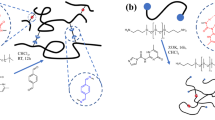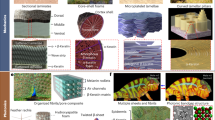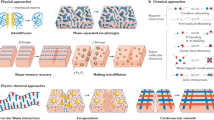Abstract
For rational design of advanced polymeric materials, it is critical to establish a clear mechanistic link between the molecular structure of a polymer and the emergent bulk mechanical properties. Despite progress towards this goal, it remains a major challenge to directly correlate the bulk mechanical performance to the nanomechanical properties of individual constituent macromolecules. Here, we show a direct correlation between the single-molecule nanomechanical properties of a biomimetic modular polymer and the mechanical characteristics of the resulting bulk material. The multi-cyclic single-molecule force spectroscopy (SMFS) data enabled quantitative derivation of the asymmetric potential energy profile of individual module rupture and re-folding, in which a steep dissociative pathway accounted for the high plateau modulus, while a shallow associative well explained the energy-dissipative hysteresis and dynamic, adaptive recovery. These results demonstrate the potential for SMFS to serve as a guide for future rational design of advanced multifunctional materials.
This is a preview of subscription content, access via your institution
Access options
Subscribe to this journal
Receive 12 print issues and online access
$259.00 per year
only $21.58 per issue
Buy this article
- Purchase on Springer Link
- Instant access to full article PDF
Prices may be subject to local taxes which are calculated during checkout





Similar content being viewed by others
References
Van Krevelen, D. W. & te Nijenhuis, K. Properties of Polymers: Their Correlation with Chemical Structure; Their Numerical Estimation and Prediction from Additive Group Contributions 4th edn (Elsevier, 2009).
Hearle, J. W. S. Polymers and Their Properties: Fundamentals of Structure and Mechanics Vol. 1 (Halstead Press, 1982).
Flory, P. J. Principles of Polymer Chemistry (Cornell Univ. Press, 1953).
Keten, S., Xu, Z., Ihle, B. & Buehler, M. J. Nanoconfinement controls stiffness, strength and mechanical toughness of β-sheet crystals in silk. Nature Mater. 9, 359–367 (2010).
Meijer, H. E. H. & Govaert, L. E. Mechanical performance of polymer systems: The relation between structure and properties. Prog. Polym. Sci. 30, 915–938 (2005).
Yount, W. C., Loveless, D. M. & Craig, S. L. Small-molecule dynamics and mechanisms underlying the macroscopic mechanical properties of coordinatively cross-linked polymer networks. J. Am. Chem. Soc. 127, 14488–14496 (2005).
Serpe, M. J. & Craig, S. L. Physical organic chemistry of supramolecular polymers. Langmuir 23, 1626–1634 (2006).
Halary, J-L., Lauprêtre, F. & Monnerie, L. Polymer Materials: Macroscopic Properties and Molecular Interpretations (John Wiley, 2011).
Janshoff, A., Neitzert, M., Oberdörfer, Y. & Fuchs, H. Force spectroscopy of molecular systems—single molecule spectroscopy of polymers and biomolecules. Angew. Chem. Int. Ed. 39, 3212–3237 (2000).
Rief, M., Gautel, M., Oesterhelt, F., Fernandez, J. M. & Gaub, H. E. Reversible unfolding of individual titin immunoglobulin domains by AFM. Science 276, 1109–1112 (1997).
Marszalek, P. E. et al. Mechanical unfolding intermediates in titin modules. Nature 402, 100–103 (1999).
Oberhauser, A. F., Marszalek, P. E., Erickson, H. P. & Fernandez, J. M. The molecular elasticity of the extracellular matrix protein tenascin. Nature 393, 181–185 (1998).
Kellermayer, M. S. Z., Smith, S. B., Granzier, H. L. & Bustamante, C. Folding–unfolding transitions in single titin molecules characterized with laser tweezers. Science 276, 1112–1116 (1997).
Rief, M., Gautel, M., Schemmel, A. & Gaub, H. E. The mechanical stability of immunoglobulin and fibronectin III domains in the muscle protein titin measured by atomic force microscopy. Biophys. J. 75, 3008–3014 (1998).
Carrion-Vazquez, M. et al. Mechanical and chemical unfolding of a single protein: A comparison. Proc. Natl Acad. Sci. USA 96, 3694–3699 (1999).
Lee, H., Scherer, N. F. & Messersmith, P. B. Single-molecule mechanics of mussel adhesion. Proc. Natl Acad. Sci. USA 103, 12999–13003 (2006).
Lu, H., Isralewitz, B., Krammer, A., Vogel, V. & Schulten, K. Unfolding of titin immunoglobulin domains by steered molecular dynamics simulation. Biophys. J. 75, 662–671 (1998).
Lu, H. & Schulten, K. The key event in force-induced unfolding of titin’s immunoglobulin domains. Biophys. J. 79, 51–65 (2000).
Chabria, M., Hertig, S., Smith, M. L. & Vogel, V. Stretching fibronectin fibres disrupts binding of bacterial adhesins by physically destroying an epitope. Nature Commun. 1, 135 (2010).
Lv, S. et al. Designed biomaterials to mimic the mechanical properties of muscles. Nature 465, 69–73 (2010).
Guzmán, D. L., Randall, A., Baldi, P. & Guan, Z. Computational and single-molecule force studies of a macro domain protein reveal a key molecular determinant for mechanical stability. Proc. Natl Acad. Sci. USA 107, 1989–1994 (2010).
Roland, J. T. & Guan, Z. Synthesis and single-molecule studies of a well-defined biomimetic modular multidomain polymer using a peptidomimetic β-sheet module. J. Am. Chem. Soc. 126, 14328–14329 (2004).
Guan, Z. et al. Modular domain structure: A biomimetic strategy for advanced polymeric materials. J. Am. Chem. Soc. 126, 2058–2065 (2004).
Zhang, W., Zou, S., Wang, C. & Zhang, X. Single polymer chain elongation of poly(N-isopropylacrylamide) and poly(acrylamide) by atomic force microscopy. J. Phys. Chem. B 104, 10258–10264 (2000).
Janke, M. et al. Mechanically interlocked calix[4]arene dimers display reversible bond breakage under force. Nature Nanotech. 4, 225–229 (2009).
Ortiz, C. & Hadziioannou, G. Entropic elasticity of single polymer chains of poly(methacrylic acid) measured by atomic force microscopy. Macromolecules 32, 780–787 (1999).
Zou, S., Schönherr, H. & Vancso, G. J. Force spectroscopy of quadruple H-bonded dimers by AFM: Dynamic bond rupture and molecular time-temperature superposition. J. Am. Chem. Soc. 127, 11230–11231 (2005).
Sijbesma, R. P. et al. Reversible polymers formed from self-complementary monomers using quadruple hydrogen bonding. Science 278, 1601–1604 (1997).
Beijer, F. H., Sijbesma, R. P., Kooijman, H., Spek, A. L. & Meijer, E. W. Strong dimerization of ureidopyrimidones via quadruple hydrogen bonding. J. Am. Chem. Soc. 120, 6761–6769 (1998).
Kushner, A. M., Gabuchian, V., Johnson, E. G. & Guan, Z. Biomimetic design of reversibly unfolding cross-linker to enhance mechanical properties of 3D network polymers. J. Am. Chem. Soc. 129, 14110–14111 (2007).
Kushner, A. M., Vossler, J. D., Williams, G. A. & Guan, Z. A biomimetic modular polymer with tough and adaptive properties. J. Am. Chem. Soc. 131, 8766–8768 (2009).
Söntjens, S. H. M., Sijbesma, R. P., van Genderen, M. H. P. & Meijer, E. W. Stability and lifetime of quadruply hydrogen bonded 2-ureido-4[1H]-pyrimidinone dimers. J. Am. Chem. Soc. 122, 7487–7493 (2000).
Hentschel, J., Kushner, A. M., Ziller, J. & Guan, Z. Self-healing supramolecular block copolymers. Angew. Chem. Int. Ed. 51, 10561–10565 (2012).
Wagener, K. B., Boncella, J. M. & Nel, J. G. Acyclic diene metathesis (ADMET) polymerization. Macromolecules 24, 2649–2657 (1991).
Rief, M., Pascual, J., Saraste, M. & Gaub, H. E. Single molecule force spectroscopy of spectrin repeats: Low unfolding forces in helix bundles. J. Mol. Biol. 286, 553–561 (1999).
Bustamante, C., Marko, J. F., Siggia, E. D. & Smith, S. Entropic elasticity of λ-phage DNA. Science 265, 1599–1600 (1994).
Embrechts, A., Schönherr, H. & Vancso, G. J. Rupture force of single supramolecular bonds in associative polymers by AFM at fixed loading rates. J. Phys. Chem. B 112, 7359–7362 (2008).
Bell, G. I. Models for the specific adhesion of cells to cells. Science 200, 618–627 (1978).
Evans, E. & Ritchie, K. Dynamic strength of molecular adhesion bonds. Biophys. J. 72, 1541–1555 (1997).
Diezemann, G. & Janshoff, A. Dynamic force spectroscopy: Analysis of reversible bond-breaking dynamics. J. Chem. Phys. 129, 084904 (2008).
Ray, C., Brown, J. R. & Akhremitchev, B. B. Correction of systematic errors in single-molecule force spectroscopy with polymeric tethers by atomic force microscopy. J. Phys. Chem. B 111, 1963–1974 (2007).
Cowie, J. M. G. Polymers: Chemistry and Physics of Modern Materials 3rd edn (CRC Press, 2007).
Brostow, W. Performance of Plastics (Hanser/Gardner, 2000).
Holden, G., Kricheldorf, H. R. & Quirk, R. P. Thermoplastic Elastomers 1–540 3rd edn (Hanser/Gardner, 2004).
Kramers, H. A. Brownian motion in a field of force and the diffusion model of chemical reactions. Physica (Utrecht) 7, 284–304 (1940).
Glasstone, S., Laidler, K. J. & Eyring, H. The Theory of Rate Processes 480–483 (McGraw-Hill, 1941).
Roetling, J. A. Yield stress behaviour of poly(ethyl methacrylate) in the glass transition region. Polymer 6, 615–619 (1965).
Rief, M., Fernandez, J. M. & Gaub, H. E. Elastically coupled two-level systems as a model for biopolymer extensibility. Phys. Rev. Lett. 81, 4764–4767 (1998).
Benichou, I. & Givli, S. The hidden ingenuity in titin structure. Appl. Phys. Lett. 98, 091904 (2011).
Acknowledgements
We acknowledge the financial support of the US Department of Energy, Division of Materials Sciences (DE-FG02-04ER46162) (J.C. for SMFS studies), and the National Science Foundation (DMR-1217651) (A.M.K. for bulk property studies). J.C. thanks Jason Bemis at Asylum Research of Oxford Instruments in Santa Barbara, California for assistance in the set-up of cyclic SMFS studies. We also thank the Materia Inc. for supplying the Grubbs second generation metathesis catalyst.
Author information
Authors and Affiliations
Contributions
Z.G. conceived the project; Z.G., A.M.K. and J.C. planned the experiments; J.C., A.M.K. and A.C.W. performed the experiments; J.C., A.M.K. and Z.G. analysed the data; and J.C., A.M.K. and Z.G. wrote the paper.
Corresponding author
Ethics declarations
Competing interests
The authors declare no competing financial interests.
Supplementary information
Supplementary Information
Supplementary Information (PDF 3998 kb)
Rights and permissions
About this article
Cite this article
Chung, J., Kushner, A., Weisman, A. et al. Direct correlation of single-molecule properties with bulk mechanical performance for the biomimetic design of polymers. Nature Mater 13, 1055–1062 (2014). https://doi.org/10.1038/nmat4090
Received:
Accepted:
Published:
Issue Date:
DOI: https://doi.org/10.1038/nmat4090
This article is cited by
-
A catch bond mechanism with looped adhesive tethers for self-strengthening materials
Communications Materials (2023)
-
Intramolecular hydrogen bonds in a single macromolecule: Strength in high vacuum versus liquid environments
Nano Research (2022)
-
Responsive Polymers with Contraction-arisen Helicity and Biomimetic Membrane-spanning Transport Functions
Chemical Research in Chinese Universities (2022)
-
Exploring the Nanomechanical Properties of a Coordination-bond Based Supramolecular Polymer
Chinese Journal of Polymer Science (2022)
-
Single-molecule observation of mechanical isomerization of spirothiopyran and subsequent Click addition
Nano Research (2021)



